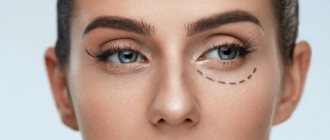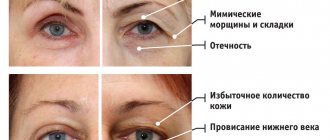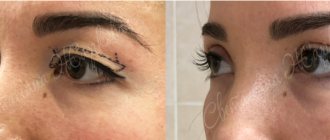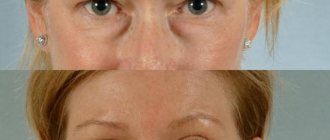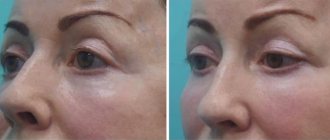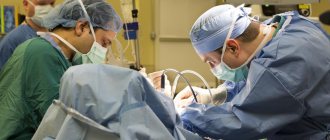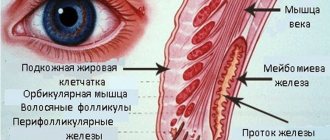Over the years, the skin tone in the eye area decreases significantly, as a result, barely noticeable wrinkles form, and the upper eyelid begins to sag. Trying to solve this problem with the help of various cosmetics is completely useless. The skin in this area is very thin. You can stop the natural aging process of the skin and make your look more youthful and expressive by having blepharoplasty.
Non-surgical blepharoplasty
When is the procedure indicated?
Non-surgical lower eyelid blepharoplasty is prescribed by cosmetologists in the following cases:
- when the skin of the eyelid hangs over the eyelashes;
- if you have bags under the eyes;
- with thinning of the epithelium in the periorbital region;
- during the formation of the nasolacrimal groove.
Most often, women turn to the procedure after 30 years. They want to tighten the skin in the eyelid area, restore its former elasticity and beauty.
How to choose the right cosmetologist?
First of all, when choosing a cosmetologist, you need to pay attention to his education. A professional cosmetologist will always be able to provide the patient with a diploma confirming receipt of specialized medical education or relevant professional retraining. You should carefully read all documents and verify their authenticity in person.
In addition, every self-respecting specialist undergoes regular advanced training courses for cosmetologists, which allow them to continue working in this field. After all, it is not enough to form basic knowledge and acquire basic skills in the field of cosmetology; it is necessary to periodically update and expand them in every possible way, in accordance with the modern technological equipment of medical institutions and the norms of labor legislation of the Russian Federation.
List of contraindications
Despite the fact that non-surgical blepharoplasty under the eyes is considered an atraumatic method, there are a number of cases when it is contraindicated for patients. Such cases include:
- high blood sugar levels (diabetes mellitus);
- the period of waiting for a child, breastfeeding;
- critical days;
- age of patients under 18 years;
- diagnosing inflammatory processes in the eye area, epithelium, various skin lesions;
- the presence of chronic diseases during exacerbation;
- mental problems;
- increased level of eye pressure;
- disorders of the thyroid gland;
- blood pathologies, problems with blood clotting.
It is also strictly prohibited to perform blepharoplasty using a non-surgical method if benign and malignant neoplasms have been detected on the body.
Experts identify a number of special contraindications. These include fear of injections, as well as situations where patients cannot tolerate or have allergic reactions to the components of the drug used.
If hardware skin tightening is planned, there are a number of additional contraindications. These include the presence of gold threads under the skin, pacemakers, and the use of hearing aids. It is recommended to plan laser rejuvenation in the autumn-winter period to minimize the effect of sunlight on the epithelium. Laser rejuvenation sessions are contraindicated if you are hypersensitive to laser beams.
Advantages and disadvantages of non-surgical treatment
Non-surgical facial blepharoplasty is considered a quick and safe method of epithelial rejuvenation. The procedure also has a number of additional advantages:
- There is no need for a long recovery period. After performing the manipulations, patients are immediately sent home; they do not need to be in the clinic. The duration of the rehabilitation period ranges from 2 to 10 hours. It is allowed to engage in work activities immediately after exposure. After 2-3 days, traces of the surgical impact disappear.
- No need for anesthesia. This allows patients of different ages to resort to the procedure, being completely confident in its safety.
- No traces after the operation. After blepharoplasty, there will be no visible or hidden incisions on the face.
- The use of atraumatic methods of exposure allows you to be sure that there is no possibility of bleeding or infection of the body.
- Leveling out coagulation and blockage of blood vessels , which minimizes the risk of blood loss and guarantees a lasting lifting effect.
- Simple rehabilitation period. It has been confirmed that after non-surgical blepharoplasty, swelling and cyanosis disappear much faster.
Thanks to non-surgical treatment, it will be possible to eliminate a small amount of excess fat in the eye area, as well as get rid of minor changes and shallow wrinkles. For this reason, non-surgical procedures help patients who are under 45 years of age.
CHTA Academy courses
The Academy of Additional Professional Education CHTA has developed advanced training and professional retraining courses specifically for medical workers in the field of cosmetology. They will help you master a new specialty or develop the qualifications of an existing one.
Distinctive features of training at the Academy
The courses are developed on the basis of distance learning and comply with all standards of domestic legislation. The study of the theoretical component takes place according to an individual program, which provides for conducting the educational process remotely.
Course participants do not need to attend lectures or combine study and work activities - all they need is an Internet connection. Today, this is the most accessible and advanced training format, because distance e-learning technologies are used in all leading universities in the country.
All courses are aimed at the most effective acquisition of new competencies and skills of the student in the field of cosmetology. This helps in solving emerging professional problems and achieving goals in the future.
After successfully completing the course and passing the certification test, trained/retrained specialists in the field of “Cosmetology” receive a certification document that officially confirms advanced training or retraining (depending on the chosen course).
Requirements for students
To attend these courses there is no need to meet any special requirements, you only need to have a specialized education. Therefore, training is available to almost anyone.
Types of non-surgical eye blepharoplasty
Blepharoplasty without surgery is possible in several ways. The most commonly used methods are laser exposure, injection manipulations and hardware. Electro blepharoplasty is no less popular. Let's take a closer look at the methods of non-surgical blepharoplasty.
Injection methods
Injection blepharoplasty involves injecting an active substance under the epithelium that has a positive (rejuvenating) effect on the skin. Preparations for non-surgical blepharoplasty are based on natural ingredients. They should not contain preservatives or artificial additives. The most commonly used means are based on:
- plant elements;
- vitamins;
- amino acids;
- hyaluronic acid;
- phytoestrogens.
The injection technique for rejuvenating the area around the eyes is divided into several more varieties:
- Type 1. Aligns the epithelium around the visual organs, changes the contour of the eyelids. This group includes biorevitalization, biorevolumetry, and the use of hyaluronic acid. The most commonly used drugs are: Stylage, Teosyal, HAfiller.
- Type 2. The method is intended to eliminate excess swelling of the eyelids. For this purpose, lipolysis is used (using injections), as well as exposure to products based on fatty acids, enzymes, and multivitamins.
Only a cosmetologist should select the appropriate type of drug and type of injection blepharoplasty, based on the skin condition of a particular patient.
Non-surgical blepharoplasty with devices
Among hardware interventions, the most common is non-surgical laser blepharoplasty. It is carried out using erbium and carbon dioxide laser devices. Thanks to the deep penetration of the rays, the skin warms up and the production of elastin and collagen is stimulated. The following types of hardware eyelid rejuvenation are also used:
- Thermage. The use of radio waves is envisaged; they activate the production and synthesis of collagen. The procedure is performed under local anesthesia.
- Smas-lifting with ultrasound. The method is based on the effect of ultrasonic waves and pulses on the deep layers of the epithelium. Due to this effect, the stretched collagen fibers “twist”. This allows you to achieve excellent tension of the epithelium, creating a lifting effect.
- Application of thermolifting. This is the name of a thermal method of influencing the skin, promoting the activation and enhancement of the process of fibroblast synthesis. This effect renews the epithelium and completely restores it. The advantage of the procedure is its impact on the deepest layers of the dermis. The results are an increase in skin tone, elimination of facial wrinkles in the periorbital area.
Separately, non-surgical plasma blepharoplasty is distinguished. This is the name of an innovative hardware technology that involves lifting eyelids using cold plasma. Thanks to this technique, wrinkles are eliminated, and the epithelium becomes more elastic and attractive. Non-surgical plasma blepharoplasty is considered an excellent alternative to current exposure, and also provides a more pronounced effect.
Electric shock
Electroblepharoplasty is the effect on the area of the upper and lower eyelids using a charged current. The main goal of the manipulations is to heat the local areas where the impact will occur. There is no pain during electroblepharoplasty; the procedure will help cope with:
- excess epithelium, contributing to eye fatigue;
- subcutaneous fatty hernias;
- "bags" in the eye area.
Also, non-surgical blepharoplasty of Asian eyes is performed in this way, allowing for high-quality Europeanization of the look.
How is blepharoplasty performed?
A non-invasive procedure for correcting the upper and lower eyelids is performed using injections and special devices. The effectiveness of the method and the almost complete absence of side effects contributes to the popularization of blepharoplasty among women.
Laser blepharoplasty
This procedure is carried out by treating the skin of the eyelids with a laser. The rejuvenating effect is achieved due to the warming effect. The method is based on the penetration of rays into the deep layers of the skin, heating them and activating the synthesis of elastin and collagen. And they, in turn, smooth out minor wrinkles and tighten sagging skin. The procedure does not require additional preparation. This type of plastic surgery has virtually no side effects and is therefore completely safe. You can achieve 100% results after 2–5 sessions. The effect lasts for 5 years.
There are separate laser blepharoplasty techniques.
- Epidermis resurfacing. The method is used to improve the structure of the skin. Using a carbon dioxide laser, a layer of dead skin is removed from the surface of the skin. To get the best result, you need to perform 4 procedures once a month.
This procedure must be carried out several times - Fractional thermolysis. A laser beam is directed to areas of the skin that need correction, which heats up the inner layers. This leads to coagulation of protein fractions, the skin regenerates. The result is a lifting effect. This method of correcting the upper eyelids requires 3 or 4 sessions, and for the lower eyelids three are enough. In the first days after the procedure, swelling and redness may appear. The result will please you for several years.
3-4 sessions of this procedure are required
Recovery after the procedure will take up to half a month. Remember that during this time you cannot use decorative cosmetics or visit swimming pools, baths or saunas. To maintain skin condition, it is advisable to use moisturizing creams and wash with warm water.
Warm water and moisturizing creams are your best “friends” after the procedure
Laser blepharoplasty has the following contraindications:
- somatic diseases;
- poor blood clotting;
- dry eyes;
- diabetes;
- period of pregnancy and breastfeeding.
Contraindications should be taken into account
Plasma current blepharoplasty
This type of correction is becoming increasingly popular. This happens because the procedure gives excellent results while its cost is not too high. The Plasma Pencil device is used. The device creates microscopic burns in the required areas. After such an “injury,” the body will restore the damaged area. The skin will become more elastic, and there will be no sagging areas.
Pros of the procedure:
- skin damage is minimal;
- You can even influence hard-to-reach areas of the skin;
- traces of impact are microscopic in size;
- fast rehabilitation period;
- The procedure is inexpensive, and the costs of materials are also insignificant.
Plasma current blepharoplasty
Non-surgical laser blepharoplasty: photo of the procedure
Laser rejuvenation is one of the most popular, so we will take a detailed look at how it is carried out. Initially, the patient comes to a meeting with a cosmetologist. There, the doctor collects anamnesis, determines allergic reactions, learns about wearing contact lenses, and the presence of chronic diseases. Also at this stage, possible contraindications are determined. Then the specialist measures and evaluates the thickness of the skin in the eye area and the level of its change.
After preliminary manipulations, the specialist sets a date for laser treatment and recommends compliance with certain rules. Immediately on the day of non-surgical treatment the following is performed:
- removing makeup residue on the face using a cleansing gel or special cosmetic milk;
- treating the skin with special anesthetics (most often gels);
- applying a protective lens to the eyeball;
- light polishing of the epithelium in the eye area.
After this, the cosmetologist selects individual settings and laser parameters for the patient’s skin. Then the process of breaking down fatty deposits in the area around the visual organs begins. This procedure is possible due to the interaction of water molecules and a laser beam.
When the procedure is completed, special cold applications and antiseptic gels are applied to the treated area. Such products minimize the possibility of bruising and swelling in the eye area.
Laser blepharoplasty is shown in the video:
Non-surgical blepharoplasty with plasma current
Plasma lifting begins with preliminary cleansing of the skin. This is followed by the application of an anesthetic; it begins to act within half an hour. Since plasma blepharoplasty is not a very painful procedure, it is not always necessary to apply an anesthetic. It depends on the wishes of the patients. First, the specialist must make markings on the face in order to determine the exact locations of the manipulations. The doctor punctures the schematic areas with a special needle. It is very important that the technician does not hold the needle in one place for a long time, as this can cause a burn. The distance between the points where non-surgical blepharoplasty will be performed depends on the level of changes required. The maximum allowable distance is 1 mm.
At the time of blepharoplasty, patients should not feel any discomfort, but only a slight warmth. There may also be a burnt hair smell.
The procedure lasts 30-65 minutes, it depends on the size of the treatment area. At the end of the exposure, an antiseptic is applied to the treated part of the face, and then a special ointment for wound healing.
Skin care after non-surgical blepharoplasty
Regardless of which method of non-surgical intervention was used, the recovery period looks approximately the same. Often after manipulations the following are observed:
- discomfort in the area around the eyes;
- slight swelling;
- burning;
- the appearance of redness on the epithelium;
- increase in body temperature;
- bruising (only after using the injection method).
All complications disappear after 5-6 days. In the places where manipulations were carried out, a crust forms, which in no case should be touched with your hands, much less peeled off. This is fraught with the formation of scars. To alleviate the condition, experts recommend using Panthenol, Bepanten, and other ointments for wound healing to treat the skin. When the crusts disappear, wound healing agents must be applied to the restored areas of the epithelium for another 2-5 days. To avoid the formation of hyperpigmentation on the epithelium, it is recommended to apply special sun protection products to the treated areas. It is optimal to select products with a protection level of 50.
Cosmetologists often recommend attending courses of procedures to moisturize the skin after performing hardware treatments. This could be bioreparation or mesotherapy. This is due to the fact that laser and plasma lead to drying of the dermis.
Ointments to prevent scars
To ensure that there are no scars left after non-surgical blepharoplasty, it is recommended to use special ointments. Let's look at them in the table.
| Product name | Characteristic |
| Gel Dermatix | Based on silicone, it helps in softening tissues, preventing the occurrence of rough scars and scarring. Improves skin water balance. |
| Contractubex | The drug is based on allonthion, due to which it promotes healing and regeneration of damaged areas on the face. The gel softens and moisturizes connective tissue, eliminating the occurrence of unpleasant sensations. |
| Kelofibrase | Natural gel that provides an anti-inflammatory effect. Improves blood circulation in the deep layers of the epithelium, eliminates the formation of scar tissue. |
Distinctive characteristics from other methods
Non-surgical treatment differs from surgical blepharoplasty in the following ways:
- precise impact on problem areas of the skin;
- no risk of infection;
- safety and non-traumatic;
- no creation of scars and cicatrices after rehabilitation;
- there is no need to use anesthesia;
- The rehabilitation period takes 2 weeks.
If you decide to undergo a hardware rejuvenation procedure, take seriously the choice of a trusted clinic.
YouTube responded with an error: The request cannot be completed because you have exceeded your quota.
Rate this article:
- Related Posts
- How is Pulsar blepharoplasty performed?
- What methods of laser neck blepharoplasty are there?
- What is plasma blepharoplasty?
- How is non-surgical abdominal blepharoplasty performed?
- What is transconjunctival blepharoplasty?
- What is tear trough blepharoplasty?
Possibility of complications
After any type of non-surgical blepharoplasty, complications may arise:
- pain in the head area;
- formation of swelling under the visual organs;
- formation of swelling;
- pronounced redness in the area of manipulation.
Such phenomena usually do not cause any harm and go away on their own after 2-3 days. If complications remain on the body for 5 or more days, you should urgently consult a doctor.
List of restrictions
After the hardware treatment, it is recommended not to use foundation or powder in areas where crusts have formed. Otherwise, the skin may become infected with bacteria. The invasive technique also eliminates the use of decorative cosmetics until the punctures have completely healed. This is best avoided so as not to infect the epithelium. During the first week after the manipulations, it is recommended not to visit saunas, solariums and swimming pools. For sleeping, it is better to choose a position on your back so that your head is slightly elevated.
Effect duration
Most women, before venturing into anti-aging procedures, are interested in the duration of the effect. This depends on the individual skin indications, as well as the method used for eyelid lifting. Laser and plasma technologies guarantee results lasting 5-7 years. The use of anti-aging injections allows you to forget about aging for 3-5 years. SMAS-impact guarantees achievement of the desired result for up to 8 years. Thermolifting will delight patients for 4 years.
Preparation for the event
Before you agree to undergo correction, you should consult a doctor about the method of performing eyelid surgery. It is necessary to check the body for contraindications to the procedure and possible allergies to the administered drugs. When performing blepharoplasty through injections, you need to avoid drinking alcohol and drugs with an anticoagulant effect 2 days before the procedure. You should not peel the day before the procedure.
Answers to frequently asked questions
Can non-surgical blepharoplasty replace surgery? Non-surgical blepharoplasty can be an alternative to surgery, but it provides results in less time. This depends on the method of rejuvenation, as well as individual indications. At what age can non-surgical blepharoplasty be performed? The non-surgical rejuvenation procedure is carried out starting from the age of 18. But for it to be carried out there must be certain indications. This can be discussed in consultation with a specialist. Is it true that a non-surgical facelift is painless? This type of rejuvenation of the eyelid area does not cause discomfort, since a special anesthetic is applied before any manipulation. The selection of the drug is carried out by a cosmetologist based on the patient’s medical history. Are additional procedures needed to consolidate the results obtained? After non-surgical blepharoplasty, no additional procedures will be required. Will a non-surgical eyelid lift help with hernias under the eyes? Of course, this procedure helps to cope with small hernias under the eyes. But the severity of the effect depends on each specific case.
Injection techniques
Injection blepharoplasty is the correction and tightening of the eyelids by injecting various drugs under the skin through a needle. The type of composition used for such manipulations is determined by the task facing the cosmetologist:
- If you want to correct the shape of your eyelids, as well as improve the condition of the skin in this area, it is recommended to give preference to products based on synthetic hyaluronic acid . Getting into the dermis, it attracts a significant amount of water molecules, which help give the skin a more even texture, eliminate voids, and tighten. In addition, hyaluronic acid improves skin tone and has a beneficial effect on the production of collagen and elastane fibers.
- If you want to get rid of fat folds or swelling, you should choose products based on plant extracts, enzymes , as well as any other useful components that normalize metabolism and help speed up metabolism. When introduced under the skin, the components of the medicinal product improve local processes, which promotes the breakdown of fat cells and the overall improvement of the problem area.
Injection blepharoplasty is always carried out as a course, the results from its implementation last for a maximum of two years. Injections are carried out approximately once every 7-10 days in 5-8 visits.
Recovery of the treated area takes about a week. In the first hours after the procedure, slight redness of the skin, swelling, and mild pain may be observed. For the first few days, most patients still have pronounced papules and red dots - marks from injections.
To consolidate the results obtained and speedy completion of rehabilitation, it is not recommended to visit baths, saunas, swimming pools, or solariums after injection surgery. In addition, you should not sunbathe or expose your skin to additional mechanical stress.
Video: performing injection blepharoplasty
Cost of non-surgical blepharoplasty
The final price for non-surgical blepharoplasty depends on the level of required changes in skin condition, the city where the manipulations are performed, the status of the salon or clinic, as well as the qualifications of the cosmetologist/doctor. Let's look at the prices of Moscow beauty salons for the most popular operations in the table.
| Type of non-surgical treatment | Cost per treatment per eyelid |
| Laser rejuvenation | 30,000-50,000 rubles. |
| Plasma eyelid lift | From 15,000 rubles. |
| Injection plastic | 7000-15,000 rubles. |
| Electroblepharoplasty | 10,000-20,000 rubles. |
| Ultrasonic, thermal | 9000-20,000 rubles. |
When signing up for non-surgical rejuvenation, keep in mind that some procedures are performed in sessions. Therefore, you will have to pay for several rejuvenation courses.
Possible consequences
Serious complications of non-surgical blepharoplasty (extremely rare) include:
- Sagging of the lower eyelid requires qualified medical assistance. It is treated with massage; if there is no result, surgical intervention may be required.
- Retrobulbar hematoma (contusion of the eye orbit) - in the absence of timely assistance, it threatens to deteriorate vision.
- Eye infection - antibacterial drugs are prescribed to relieve inflammation.
- Splitting of objects - goes away within the first three weeks, but requires observation by an ophthalmologist.
Attention! Before carrying out the procedure, read reviews from real patients on the forum or on the official website: read about the clinic, as well as about the cosmetologist himself. The doctor must be an experienced and qualified specialist.
Real reviews after non-surgical blepharoplasty
Review 1, Marina, 34 years old, Komsomolsk-on-Amur: After the onset of such a terrifying date for every woman, “30 years old,” I began to feel that I looked worse, and my husband was looking at young girls. I decided to sign up for laser blepharoplasty to correct the situation and tighten the skin in the eyelid area. First, I carefully read the many reviews about non-surgical blepharoplasty, and only then went for a consultation with a cosmetologist. She advised me to use the injection method of tightening, because she felt that this technique was more suitable for me. I agreed and did not regret my decision. A month after the procedure, I began to look younger and more beautiful, and most importantly, I did not have to endure pain during rehabilitation.”
Review 2, Natalia Leonidovna, 40 years old, Khabarovsk: “I had laser blepharoplasty on the advice of a friend. She did it a year earlier and very much praised the result, and she really looked younger. The procedure was divided into 3 sessions with a short interval. After each session it was difficult to use sunscreen all the time (I sometimes forgot to do this), but fortunately everything worked out and no side effects were observed. Now that 3 months have passed since the procedure, I feel not 40, but 25. My husband says I look 30.” Review 3, Svetlana, 38 years old, Murmansk: “I always try to look beautiful and stylish, I constantly monitor my appearance. I decided to undergo plasma blepharoplasty to eliminate wrinkles under the eyes. This method of rejuvenation was recommended to me by my sister. I regret that I refused anesthesia, because I experienced a little discomfort during the manipulations. After two weeks I was able to enjoy the results – small hernias under the eyes disappeared, as well as wrinkles in the eyelid area.” Review 4, Violetta, 36 years old, St. Petersburg: “I wanted to rejuvenate my skin a little, but without surgery. Of all the options listed by the cosmetologist, I liked the laser treatment method the most. The procedure was painless, there were no scars left, only small scabs that came off on their own.” Review 5, Nicole, 28 years old, Krasnodar: “Despite my young age, I have terrible bruises under my eyes. I got this inheritance from my dad. No matter what I did with them, they didn’t leave. I decided to undergo injection blepharoplasty. Despite the fact that I am afraid of injections, everything went better than I expected. I was pleasantly pleased with the result.”
